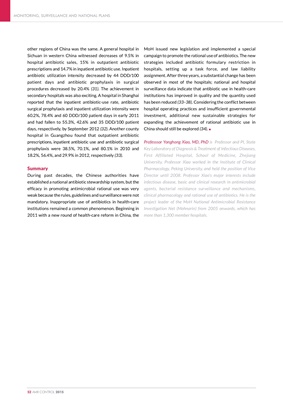
other regions of China was the same. A general hospital in
Sichuan in western China witnessed decreases of 9.5% in
hospital antibiotic sales, 15% in outpatient antibiotic
prescriptions and 14.7% in inpatient antibiotic use. Inpatient
antibiotic utilization intensity decreased by 44 DDD/100
patient days and antibiotic prophylaxis in surgical
procedures decreased by 20.4% (31). The achievement in
secondary hospitals was also exciting. A hospital in Shanghai
reported that the inpatient antibiotic-use rate, antibiotic
surgical prophylaxis and inpatient utilization intensity were
60.2%, 78.4% and 60 DDD/100 patient days in early 2011
and had fallen to 55.3%, 42.6% and 35 DDD/100 patient
days, respectively, by September 2012 (32). Another county
hospital in Guangzhou found that outpatient antibiotic
prescriptions, inpatient antibiotic use and antibiotic surgical
prophylaxis were 38.5%, 70.1%, and 80.1% in 2010 and
18.2%, 56.4%, and 29.9% in 2012, respectively (33).
Summary
During past decades, the Chinese authorities have
established a national antibiotic stewardship system, but the
efficacy in promoting antimicrobial rational use was very
weak because the rules, guidelines and surveillance were not
mandatory. Inappropriate use of antibiotics in health-care
institutions remained a common phenomenon. Beginning in
2011 with a new round of health-care reform in China, the
MoH issued new legislation and implemented a special
campaign to promote the rational use of antibiotics. The new
strategies included antibiotic formulary restriction in
hospitals, setting up a task force, and law liability
assignment. After three years, a substantial change has been
observed in most of the hospitals; national and hospital
surveillance data indicate that antibiotic use in health-care
institutions has improved in quality and the quantity used
has been reduced (33-38). Considering the conflict between
hospital operating practices and insufficient governmental
investment, additional new sustainable strategies for
expanding the achievement of rational antibiotic use in
China should still be explored (34). l
Professsor Yonghong Xiao, MD, PhD is Professor and PI, State
Key Laboratory of Diagnosis & Treatment of Infectious Diseases,
First Affiliated Hospital, School of Medicine, Zhejiang
University. Professor Xiao worked in the Institute of Clinical
Pharmacology, Peking University, and held the position of Vice
Director until 2008. Professor Xiao's major interests include
infectious disease, basic and clinical research in antimicrobial
agents, bacterial resistance surveillance and mechanisms,
clinical pharmacology and rational use of antibiotics. He is the
project leader of the MoH National Antimicrobial Resistance
Investigation Net (Mohnarin) from 2005 onwards, which has
more than 1,300 member hospitals.
MONITORING, SURVEILLANCE AND NATIONAL PLANS
52 AMR CONTROL 2015